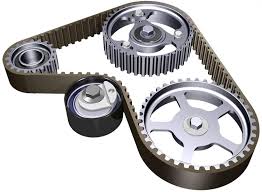Umar Farooq Belting Products: Elevating Automotive Precision with Auto Timing Belts
Welcome to Umar Farooq Belting Products, where innovation meets reliability in the realm of automotive solutions. As a distinguished provider, we take pride in offering a premium selection of Auto Timing Belts, featuring renowned brands such as Bando, Mitsubishi, Sun, and high-quality Chinese brands. Our commitment to excellence ensures that you experience optimal performance, durability, and precision in every drive.
Auto Timing Belts: Unleashing Precision in Motion
Our Auto Timing Belts are meticulously crafted to synchronize the engine’s camshaft and crankshaft, optimizing the performance of your vehicle’s powertrain. These belts play a critical role in maintaining precise engine timing, enhancing fuel efficiency, and preventing potential damage to vital engine components.
Featured Brands:
- Bando: Umar Farooq Belting Products proudly presents Bando, a globally recognized brand synonymous with quality and innovation. Bando Auto Timing Belts are engineered to meet stringent standards, providing reliable and consistent performance, ensuring your vehicle operates at its peak.
- Mitsubishi: Elevate your driving experience with Mitsubishi Auto Timing Belts, known for their precision and durability. Mitsubishi has a rich history of excellence in automotive technology, and their timing belts are no exception. Trust in the reliability of Mitsubishi for a smooth and efficient engine operation.
- Sun: Our collection includes Sun Auto Timing Belts, a brand that exemplifies cutting-edge technology and performance. Sun belts are designed to withstand the demanding conditions of modern engines, delivering exceptional reliability and longevity.
- High-Quality Chinese Brands: Umar Farooq Belting Products is pleased to offer a selection of high-quality Chinese brands, known for their commitment to excellence in manufacturing. These brands are carefully curated to ensure that you have access to a diverse range of options, meeting the highest industry standards.
Why Choose Umar Farooq Belting Products:
- Diverse Selection: Explore a comprehensive range of Auto Timing Belts from leading international and Chinese brands, providing you with the flexibility to choose the best fit for your vehicle.
- Quality Assurance: Our commitment to quality is unwavering. Each Auto Timing Belt in our inventory undergoes rigorous testing to ensure it meets or exceeds industry standards.
- Expert Support: Have questions or need assistance in choosing the right timing belt for your vehicle? Our expert support team is here to guide you, ensuring a seamless and informed buying experience.
Umar Farooq Belting Products invites you to experience the precision, reliability, and innovation embodied in our Auto Timing Belts. Drive with confidence, knowing that your vehicle is equipped with the finest automotive components from trusted brands.
Some more details
Certain engines with overhead camshafts have timing belts that have a limited life span. Car makers use these belts instead of more durable chains because chains are noisier and cost more to manufacture. Your vehicle owner’s manual will recommend at what mileage the timing belt must be replaced. These intervals range from every 60,000 miles to every 105,000 miles. To see what is recommended for your engine, click on the link at the bottom of this article.
The job of the timing belt is to turn the camshaft(s) at exactly 1/2 the speed of the crankshaft while maintaining a precise alignment. This means that the crankshaft will make two revolutions for every revolution of the camshaft. Engines will have at least one camshaft, or as many as four camshafts in some of the V-type engines. The camshaft causes the intake and exhaust valves to open and close in time with the pistons which move up and down in the cylinders. The valves must open and close at exactly the right time in relationship to the piston movement in order for the engine to run properly. For more information on how this works, go to “A Short Course on Engines
There are two types of engines that use timing belts. They are described as: “Interference Engines” and “Non-interference Engines” The difference lies in the proximity between the valves and the pistons. On an interference engine, if the timing belt slips even one notch, the piston can crash into an open valve causing serious engine damage by bending valves and breaking pistons. Non-interference engines will usually not self destruct, but in either case if the belt fails, the engine will immediately shut down leaving you stranded. The link at the bottom of this article will tell you which category your engine falls under.
Timing belts fail without warning and on some vehicles, are almost as hard to check as they are to change. In most cases, your only protection is to change the belt at the recommended intervals. Timing belt replacement is not a cheap job but it is far less costly than the alternative.
Some technicians may recommend that you replace the water pump during a timing belt job even if there is nothing wrong with it. This is because 90% of the labor to change the water pump has already been done with the timing belt job and some technicians consider it good insurance to replace the pump at this time. My feeling is that some water pumps can last the life of the car but many do fail and will cost big money to replace at a later date. So ask your technician what his experience is with the water pump on your model car and look at how long you plan to keep the car. This way, at least you will be making an informed roll of the dice.
Auto Timing belt
|
||||||||||||||||||||||||||||||||||||||||||||||||||||||||||||||||||||||||||||||||||||||||||||||||||||||||
